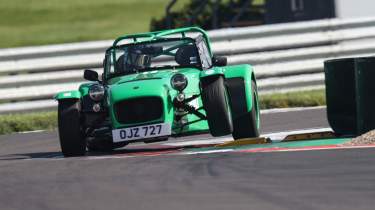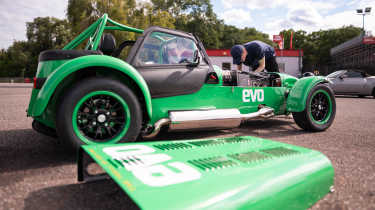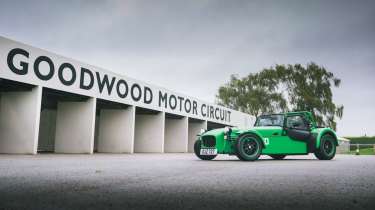Caterham Seven evo25 Fast Fleet test – living with a track car for the road
25 years of evo, 50 years of Caterham – the perfect excuse to create a unique Seven to celebrate both brands’ milestones. So how did we spec it, and did we get our choices right?
Our journey to Goodwood for evo Trackdays was to prove a remarkably complete, 24-hour test of the Caterham Seven whose specification I had helped decide. My suggestion to Caterham’s CCO, David Ridley, that it would be neat to celebrate evo’s 25th anniversary and Caterham’s 50th by adding a Seven to the evo long-term test fleet was met enthusiastically. Over the following weeks editor Stu and I lost hours on the excellent Caterham configurator, firing suggestions back and forth, homing in on the ideal spec.
What we wanted was a car that would blend everyday comfort (for a Seven) with excellent trackday capability, which resulted in a cross between the road 420 and track-biased 420R, based on the narrow chassis with lowered floors. For habitability we have the ‘Trackday’ roll-cage (a full cage but with less-restrictive roof bars than the Sport and Race versions, making for easier access), the comfort seats, quieter rear-exit exhaust, a heater and full weather equipment. On the track side we have 420 Cup mechanicals, with the 2-litre Duratec engine, dry-sumped and hooked up to a five-speed manual, plus wide-track front suspension, a limited-slip diff, ten-setting adjustable Bilstein dampers and Avon ZZS tyres on lightweight 13-inch wheels. The rims of said wheels are painted BMW Signal Green to match the body, while the seats are part-cloth, with a houndstooth material, illustrating Caterham’s ability to provide bespoke finishes. Golf GTI tartan inserts were also an option.
More reviews
Group tests
- Ariel Atom 4R v Caterham Seven ‘evo25’: power-to-weight heroes go head-to-head
- Caterham Super Seven 600 v Super Seven 2000
Long term tests
Reviews
> Mazda MX-5 2.0 Fast Fleet test – 12 months in the featherweight roadster
The test of our choices began less than half an hour from the office when we got stuck in the fallout from the M1 being closed. All the roads nearby were jammed, so we spent an hour and a half shadowing the motorway at very low speed. The Seven didn’t get flustered but we got rather warm, flinging open the simple doors whenever stationary to get a breeze through the cabin.
The steering is quite weighty because of the relatively wide, 185/55 front tyres (the rears are 215/55s) but the engine is effortlessly tractable, the clutch and gearshift well weighted and, when we finally got onto clear motorway, we found the exhaust reasonably quiet. We went for the race-spec fuel tank, which gives a small-ish, 36-litre capacity that we had reckoned in the worst case should take us at least 150 miles. The gauge suggested we were doing much better than that, the needle not yet at the half-full mark by the time we swept onto the M25, so it was quite alarming 20 miles later to spot the needle on zero. We backed off and soft-pedalled it to the nearest gas station where we found it would take only 16 litres… and the needle stayed on zero. Hmmm. Still, 35mpg was a pleasant surprise, and a few miles on, the gauge was working again.
A Seven is a cosy place to be at night on the A3, the interior bathed in a light blue glow from the minor switch lights. You do feel a little vulnerable though, because the view in all the mirrors is a little distorted and every other car that comes piling by is a chubby, high-rise SUV with wheelarch brows level with your eyeline.
I’ve never driven the Goodwood circuit before, but I’ve seen plenty of racing on it, particularly enjoying the Revival coverage that has often featured one R Meaden Esq at the pointy end. Given the weather forecast looked dodgy for evo’s trackday, I made sure I got out as soon as possible after I’d done the first-timer sighting laps, which had revealed what I already suspected: to go quick here, you have to be confident and brave.
I didn’t feel I was either of those things exiting the pitlane, but any Caterham is the perfect learner car because it’s fast enough on the straights and very light, so if you arrive too fast or on the wrong line for a corner you can usually correct things. I’d worried that the weighty steering would put a dampener on its on-limit playfulness but once I had a feel for the lines, it all became about the rear and managing mild, power-induced slip. It was brilliant fun, tactile and transparent, carrying speed where bigger, heavier cars were tentative, its braking points tens of yards after those same cars.
All the time at Goodwood comes from having the confidence to carry speed into the corners – all of them – arcing in for the apex with the car up on its toes, all four tyres on the limit of adhesion. As your commitment creeps up, you realise that to go really fast, you have to factor in the mid-corner crest at the first corner, Madgwick, the drop after the apex at St Mary’s, and aim for the second apex at Woodcote. It’s brilliant but you don’t want to get it wrong.
My colleague James Taylor had taken delivery of our Seven and given it its shakedown test at our Brands Hatch trackday. He had nothing but praise for its performance and handling. However, he did note that it had an appetite for oil and topped up the dry-sump tank a couple of times. I kept a close eye on it at Goodwood and it didn’t drink a drop. Odd, but in a good way.
Caterham’s staff told James that the car is very responsive to damper settings, giving everything from a ‘featherbed’ on 1 to super-sporty on 10, and that softening them off for the wet makes a huge difference. So when the rain started to fall at Goodwood, we backed off the Bilsteins from 8 to 3. It’s the easiest thing to do and even in the paddock the change in stiffness was obvious; the rear squatted just letting the clutch out.
On track it was amazing. The surface was fully wet but the rain was very light initially and I was amazed at how much traction and grip the scantily treaded Avons found. The balance of the car was just as it had been in the dry, the rear breaking away in exactly the same places, the speeds feeling close too. The rain got gradually heavier, the surface becoming properly wetted and traction reducing further, but the handling was still progressive and even with the wipers on, the braking points seemed not far off where they’d been in the dry. We passed most of the ‘regular’ cars in that session and it was properly absorbing, entertaining and rewarding.
Unexpectedly, Goodwood has joined my list of circuits I’d jump at the chance of driving again. As expected, the evo25 Seven proved great on road and quite superb on track.
This story was first featured in evo issue 315.






